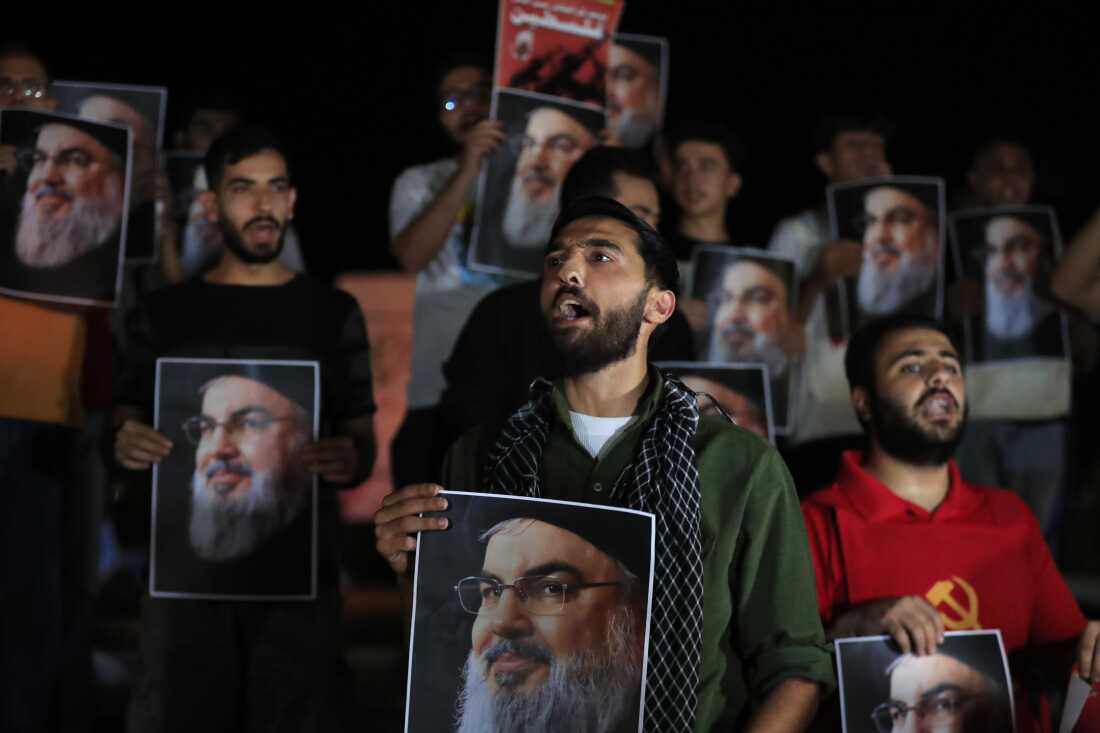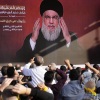
A portrait of Hezbollah chief Hassan Nasrallah sits amid destruction in an space focused in a single day by Israeli airstrikes in Saksakiyeh on Sept. 26.
Mahmous Zayyat/AFP by way of Getty Photographs
disguise caption
toggle caption
Mahmous Zayyat/AFP by way of Getty Photographs
Israel introduced on Saturday that it had killed Hassan Nasrallah, the longtime chief of Hezbollah, in a robust collection of airstrikes that rocked Beirut on Friday night. The Iranian-backed militia later confirmed Nasrallah’s dying.
The announcement got here after an eventful and lethal 12 days within the preventing between Israel and Hezbollah — together with the killing of a number of different high-ranking Hezbollah officers and greater than 1,000 individuals in Lebanon after a collection of near-synchronized explosions adopted by 1000’s of Israeli airstrikes over a number of days. These assaults left 1000’s extra wounded and displaced tens of 1000’s of individuals.
Hezbollah additionally retaliated towards Israel, firing a whole lot of rockets towards northern Israel, and at the very least one long-range cruise missile towards Tel Aviv, which was intercepted by Israel’s air protection system. It was the primary time the militant group had ever executed so. Though most of those projectiles had been shot down, a number of did make it by means of, inflicting harm to residential houses, a regional hospital and injuring a number of civilians.
Right here’s a extra detailed timeline of how these dramatic occasions unfolded:
Sept. 17: 1000’s of pagers — many belonging to Hezbollah members — concurrently explode throughout Lebanon and Syria, killing at the very least 13 individuals, together with some youngsters, and injuring round 4,000, a whole lot of them critically. Israel is broadly believed to be behind the assault, however doesn’t publicly take credit score for it. Earlier within the day, Israel had introduced a brand new purpose within the conflict: to return tens of 1000’s of displaced Israelis who had been pushed from their houses close to the border with Lebanon by virtually a yr of Hezbollah rocket hearth, signaling it’d take additional navy motion towards Hezbollah.

A funeral ceremony is held on Sept. 18 within the Dahiyeh neighborhood, south of the capital Beirut, for 4 individuals who had been killed in Lebanon when pagers utilized by Hezbollah members detonated.
Houssam Shbaro/Anadolu by way of Getty Photographs
disguise caption
toggle caption
Houssam Shbaro/Anadolu by way of Getty Photographs
Sept. 18: A contemporary wave of explosions of communications units, together with walkie-talkies, strikes Lebanon, killing 14 and wounding some 450, in keeping with Lebanese well being officers. Israeli Protection Minister Yoav Gallant speaks about “excellent achievements” by Israel’s navy and intelligence branches resulting in “impressive results,” however doesn’t point out the gadget assaults of the earlier two days.

A person reacts on whereas holding a Hezbollah flag throughout the funeral on Sept. 18 in Beirut for individuals killed after pagers exploded in a lethal wave throughout Lebanon yesterday.
Anwar Amro/AFP by way of Getty Photographs
disguise caption
toggle caption
Anwar Amro/AFP by way of Getty Photographs
Sept. 19: Israel says it struck a whole lot of rocket launchers in southern Lebanon, placing them out of fee.
Sept. 20: Israel strikes a residential constructing in a crowded Beirut suburb throughout rush hour, later asserting it has killed Ibrahim Akil, Hezbollah’s navy commander. Thirty-seven individuals had been killed within the strike, together with total households, and dozens had been wounded. Hezbollah later confirmed Akil’s dying, together with 15 different Hezbollah members. Akil had been needed by the U.S. for involvement in a lethal assault on the U.S. Embassy in Beirut in 1983, in keeping with the State Division. The Israeli navy stated Akil was planning an assault on northern Israel, just like the Hamas-led assault final Oct. 7 that sparked the conflict in Gaza.
Sept. 21: The Israeli Air Power strikes roughly 400 Hezbollah targets in Lebanon, together with rocket launchers and extra navy infrastructure in southern Lebanon, saying that the launchers had been aimed toward Israel. Lebanon’s inside minister, Bassam Mawlawi, says its intelligence businesses are working to dismantle a spy community, saying that Lebanon is in a “delicate and dangerous” safety local weather.

Rescuers sift by means of the rubble on the scene of an Israeli strike that focused Beirut’s southern suburbs a day earlier, as search and rescue operations proceed on Sept. 21.
AFP/by way of Getty Photographs
disguise caption
toggle caption
AFP/by way of Getty Photographs
Sept. 22: Hezbollah and Israel commerce heavy hearth in a single day and into the early morning hours. In southern Lebanon, residents described large explosions that lit up the night time sky. The Israeli navy stated it hit some 290 targets, together with Hezbollah rocket launchers, whereas a few of Hezbollah’s rockets hit deeper into Israel than they’ve beforehand on this conflict.
Sept. 23: Israel calls on residents of southern Lebanon to go away solely hours earlier than blanketing the realm with greater than 1,300 airstrikes. These strikes kill at the very least 558 individuals, together with ladies, youngsters and well being care staff, and injure greater than 1,800, in keeping with Lebanon’s ministry of well being. That is the very best single-day dying toll in Lebanon in a long time. On the identical day, Hezbollah fires round 200 rockets at northern Israel, most of which had been intercepted by Israel’s aerial protection system. Within the night, Israel strikes an condo in Beirut the place Ali Karaki, Hezbollah’s southern entrance commander and third within the group’s hierarchy, was staying. He survives.
Sirens sound within the northern Israeli metropolis of Haifa and close by cities. Israel stated Haifa was focused for the primary time for the reason that conflict started practically a yr in the past.

Smoke billows from a web site focused by Israeli shelling within the southern Lebanese village of Zaita on Sept. 23. The Israeli navy on Sept. 23 instructed individuals in Lebanon to maneuver away from Hezbollah targets and vowed to hold out extra “extensive and precise” strikes towards the Iran-backed group.
Mahmoud Zayyat/AFP by way of Getty Photographs
disguise caption
toggle caption
Mahmoud Zayyat/AFP by way of Getty Photographs
Sept. 24: Hezbollah and Israel proceed to commerce hearth by means of the night time. Israel points extra warnings to residents in southern Lebanon to flee, whereas closely bombarding the realm with a whole lot of further airstrikes, killing dozens extra — together with two U.N. staff — and wounding many others. Iran’s president warns in an interview with CNN that Lebanon should not change into “another Gaza at the hands of Israel.” Israel says a strike in Beirut killed the pinnacle of Hezbollah’s missile division, Ibrahim Kobeissi.
Sept. 25: Early within the morning, Hezbollah launches a long-range missile that reaches Tel Aviv airspace earlier than being shot down by Israeli forces — the primary time the militant group has launched a missile like this towards central Israel. Israel continued its airstrike marketing campaign throughout a lot of southern Lebanon, killing at the very least one other 72 individuals and injuring about 400, in keeping with Lebanese well being officers. The Israeli navy additionally broadcasts it’s calling up two further brigades of reserves for the north, saying that it should “prepare very strongly” for a floor invasion into southern Lebanon.

Individuals examine the positioning of an Israeli airstrike in Jiyeh alongside the freeway linking Beirut to the southern metropolis of Sidon on Sept. 25. In south Lebanon, a stronghold of Hezbollah, Israeli warplanes bombed villages for a 3rd day on Sept. 25, after airstrikes earlier within the week killed at the very least 558 individuals within the deadliest day of violence for the reason that 1975-1990 civil conflict.
Mahmoud Zayyat/AFP by way of Getty Photographs
disguise caption
toggle caption
Mahmoud Zayyat/AFP by way of Getty Photographs
Sept. 26: Amidst the backdrop of the United Nations Basic Meeting in New York, the U.S. and France, backed by different members of the G-7, suggest a 21-day cease-fire plan between Israel and Lebanon. Israeli officers, together with Prime Minister Benjamin Netanyahu, are fast to reject it.
Hezbollah fires dozens of rockets towards northern Israel, most of which had been intercepted, whereas Israel says it carried out greater than 200 airstrikes in Lebanon, killing one other 92 individuals and wounding greater than 150, in keeping with Lebanese well being officers. This brings the entire variety of individuals killed in Lebanon by Israeli airstrikes throughout the week to greater than 700. Tens of 1000’s of Lebanese are displaced whereas fleeing Israel’s fixed bombardment. Lebanese officers say it’s the nation’s largest displacement in a long time.
Later, Israel says it has killed Hezbollah’s air drive commander, Mohammed Hussein Sarour, in a strike in southern Beirut.
Sept. 27: In a fiery speech on the United Nations Basic Meeting in New York, Netanyahu says Israel is “winning” on a number of fronts and would assault Iran and its proxies anyplace within the Center East. Lots of the delegates within the U.N. corridor depart in a public snub initially of his handle — by which he calls the U.N. a “swamp of antisemitic bile.”

Israeli Prime Minister Benjamin Netanyahu addresses world leaders throughout the United Nations Basic Meeting on Sept. 27 in New York Metropolis.
Spencer Platt/Getty Photographs
disguise caption
toggle caption
Spencer Platt/Getty Photographs
Shortly after Netanyahu finishes talking, a number of Israeli airstrikes rock southern Beirut in a collection of blasts that may be felt across the metropolis. The strikes demolished a number of residential buildings in southern Beirut, which Israeli officers virtually instantly label the headquarters of Hezbollah, even because the smoke and particles clouds from the explosion rose above the town.
Sept. 28: A number of hours later, the Israeli navy broadcasts that Hezbollah chief Hassan Nasrallah was killed within the strike in Beirut. Hezbollah later confirms his dying. Analysts say the killing of Nasrallah has remodeled an already complicated and lethal regional battle, with a broad array of potential outcomes for Israel, Gaza, Lebanon and past.

Lebanese and Palestinian males maintain portraits of Hezbollah chief Hassan Nasrallah throughout a protest within the southern port metropolis of Sidon, Lebanon, on Sept. 28.
Mohammed Zaatari/AP
disguise caption
toggle caption
Mohammed Zaatari/AP




